How to write automated tests for APIs with Postman – Part 2
In the last tutorial we discussed how to set up Jetpacks and write a basic test for a sample API endpoint. The test checked the response status code and the Content-Type header against known values.
In this tutorial, we’ll write a more comprehensive test. We’ll use the super-useful JSONBlob API. This API lets you create, update, and delete content on the server. We’ll use it to mimic a blog. This mirrors common API usage scenarios and will be helpful in demonstrating how Postman can make things easier for you.
Do remember that the API is only for demo purposes and does not follow the best security practices.
1. Create an environment
In this tutorial, we’ll use environment variables. Create an environment with the following values:
Select the environment in the environment list to activate it. We’ll use test scripts to fill this environment with more values.
2. POST request to create a new blog post
To create a new blog post, we’ll need to send a POST request to {{url}}/api/jsonBlob with the following request body:
{
"content": "My first blog post :)"
}
This endpoint will return a “Location” header, with the URL of the newly created blog post:
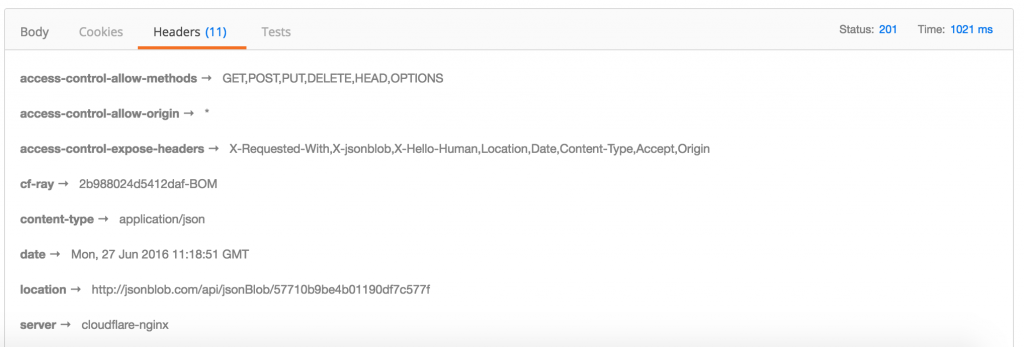
Let’s use the test script feature to extract this header and store it:
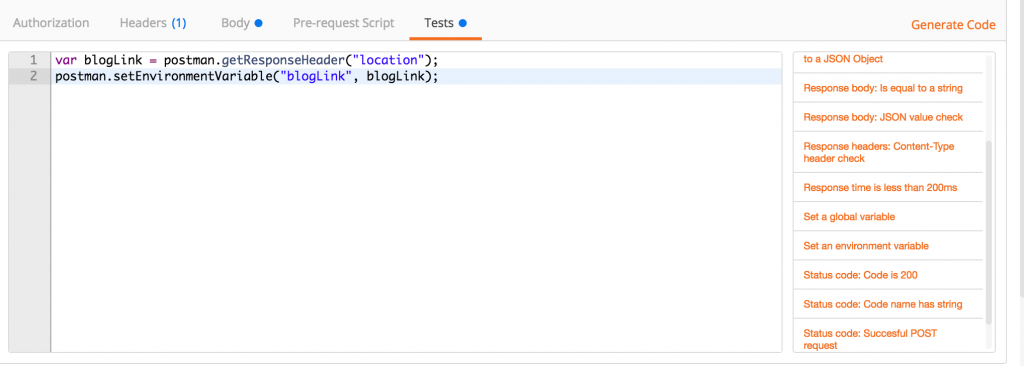
Save this request to a collection.
3. Validate that the post was created
We can now make a GET call to the saved URL to make sure the blog post was created. Set the URL to {{blogLink}}, and add a test script to validate the contents.
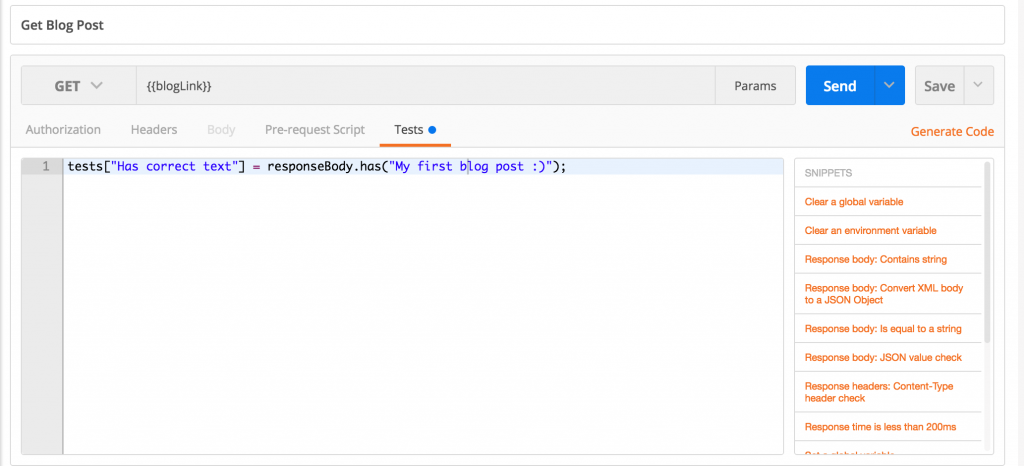
4. Update the blog post
We can update existing blog posts using the PUT method. Set the URL to {{blogLink}}, since we know the blog post we want to update. Let’s update the blog content to:
{
"content": "My first blog post, updated :)"
}
5. Verify that the contents have been updated
We can use a modified version of the GET request we created in step 3. All we need to do is change the test script to:
tests["Has correct updated text"] =
responseBody.has("My first blog post, updated :)");
6. Delete the blog post
Change the GET to DELETE to remove the blog post from the server.
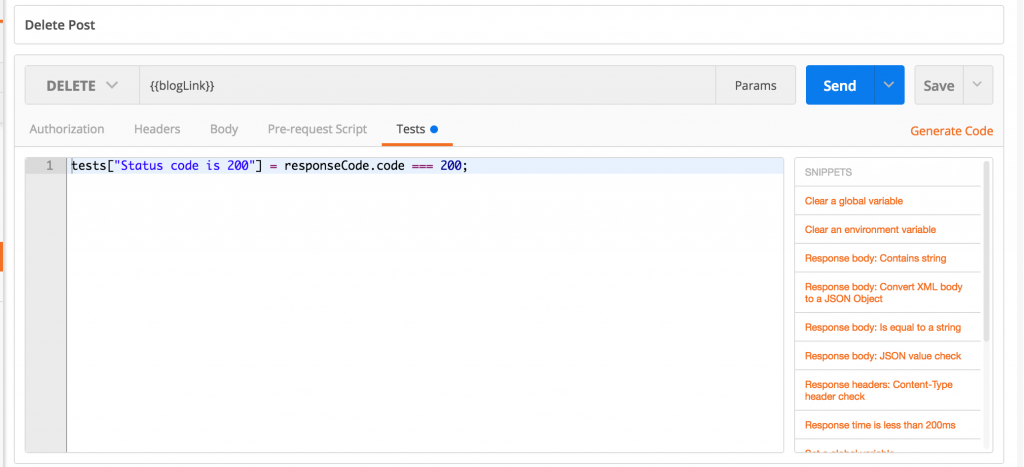
7. Verify that the blog post has been deleted
Now that we’ve deleted the post, let’s verify that the blog URL no longer returns any content. Use the same URL as the previous GET requests, and change the test script to
tests["Status code is 404"] =
responseCode.code === 404;
A 404 response code indicates that the entity we requested was not found.
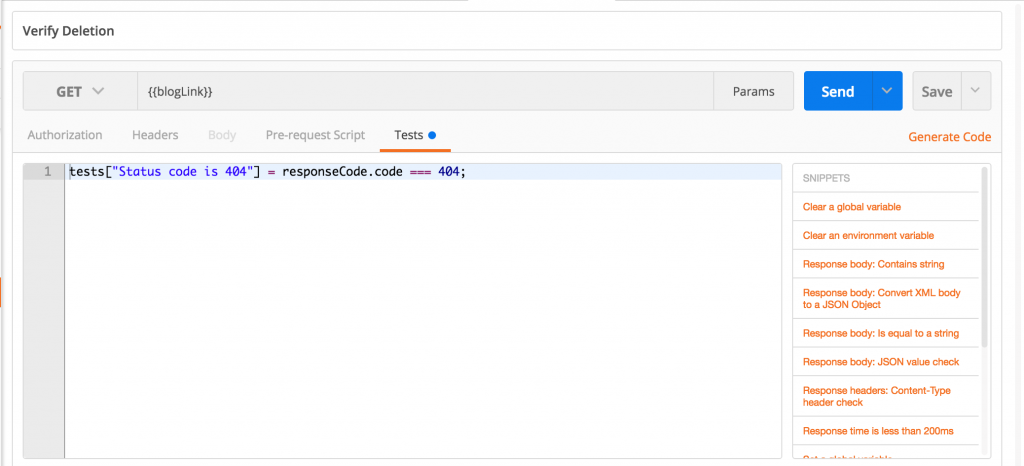
Running the request says that everything went well. Postman would notify you of errors if something did not go as per expectations. To check for Javascript errors in your code, you can open the Chrome Console and monitor the logs.
You can download this collection here.
In the next tutorial, we’ll look at the collection runner and how we can run this entire collection in one click using the Collection Runner.
The “How to write automated test with Postman” series
Update: See how to write tests using the newer PM API (known as the pm.*API).
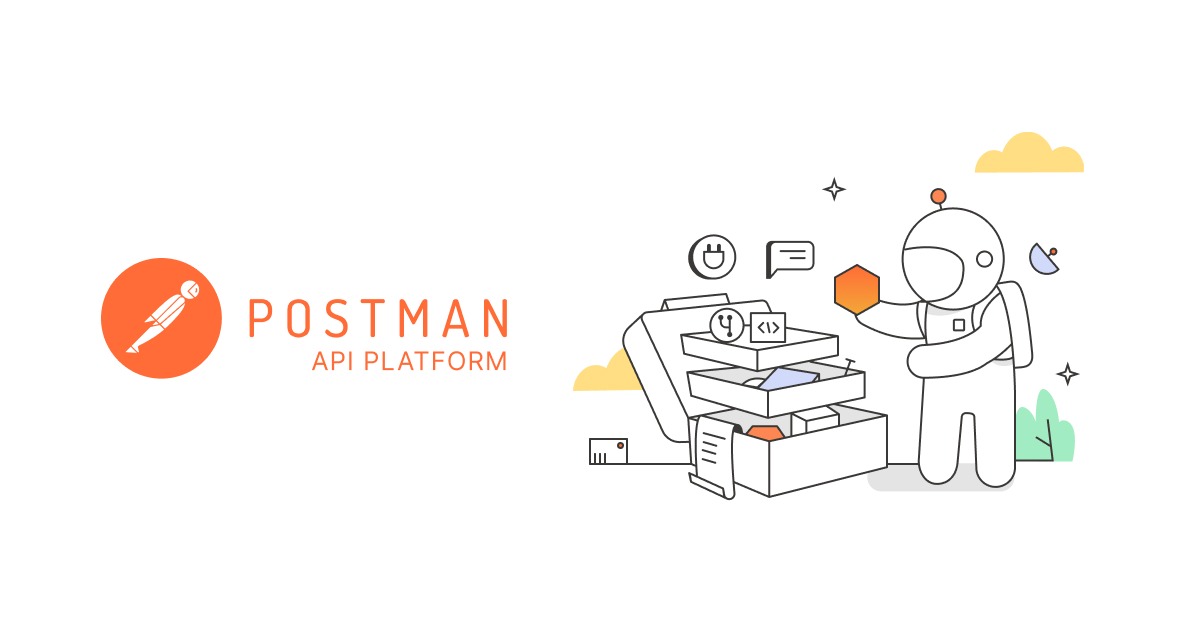

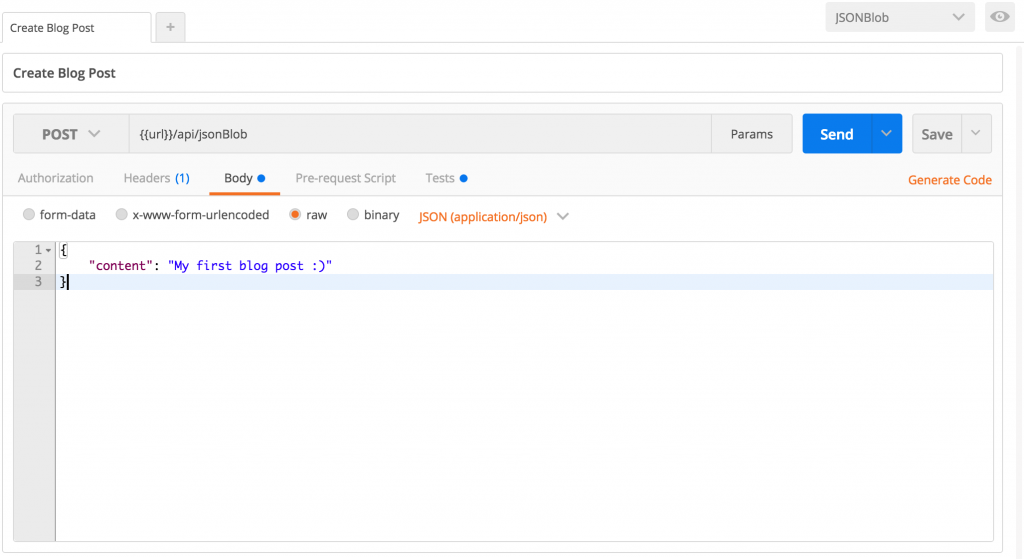

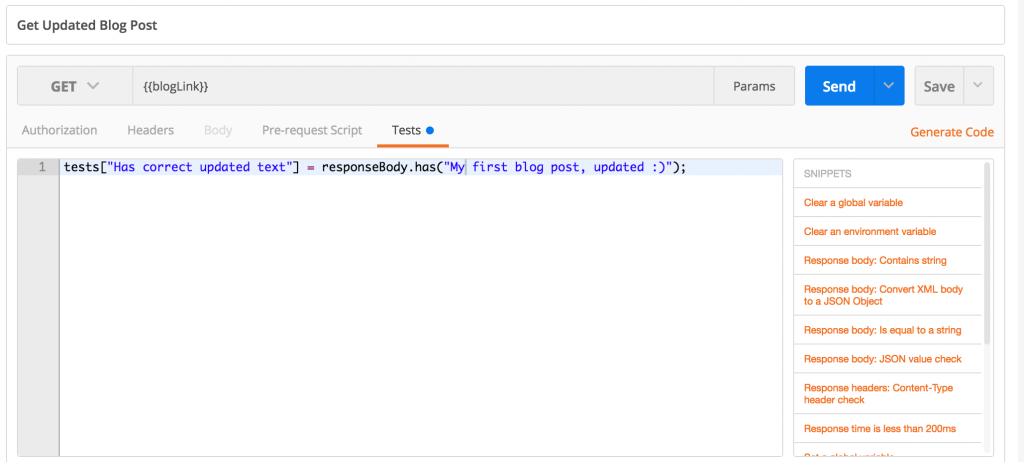
Have recently started using this tool and find it really good. Very lightweight and easy to use. I was hoping to be able to build it into our existing test automation system. Currently I run the api test locally on my mac against the desired environment but I was hoping to be able to build it into our existing test automation system. Currently we have rspec/capybara integration tests that are run via Jenkins hosted on an ubuntu machine. I would like to have the api tests ran via a Jenkins job also, and on successful completion of this job it would kick off the other rspec/capybara integration jobs. Is it possible to use this tool via Jenkins?
Thanks! Postman has a companion command line tool called Newman now which let’s you integrate Postman collections with Jenkins. No need to write any extra code! Check out the blog post here: https://blog.postman.com/index.php/2014/05/12/meet-newman-a-command-line-companion-for-postman/
Perfect. Thanks for the prompt response, will look into this tool today!
Does postman let you load different tests cases?
– we’d like to define all the endpoints once,
– define multiple variations of data used in various scenarios against those endpoints
– define multiple variations of tests.
A simple example is:
– posting valid json to an endpoint, expected result here is 200
– posting invalid json to the same endpoint, result here should be 40x and particular response.body
Suggestion:
In response to a POST to http://dump.getpostman.com/blog/posts with bad credentials the response code is 200 OK with the following as the JSON body.
{
“message”: “Invalid credentials”
}
I would recommend that the response be a 401 UNAUTHORIZED.
Agree with you. I have added it to the issue tracker here: https://github.com/a85/Postman-demo-server/issues/1
II have a scenario where i need to login in order to fetch the cities list but where i need to run a login api by which i will be getting user_id and token and these data i’ll be putting up in fetchcitieslist api where i’ll be getting up the list for the particular user_id, but when i am trying to follow the above steps i am not able to do so, Could you please help me out
Can you mention the exact problem you are getting , so we can check whats the exact problem.. input , output or some snapshots
I guess the question was:
Is it possible to execute Login before all other test(folders)?
Like this:
– Login and obtain token and user_id. Put it into environment variable {{token}} {{user}}
– Use it in all other tests (Authorization header)
In runner it’s not possible to select order of folder, so I did like this:
– Posts (folder)
– – Login
– – Create post
– – Edit post
– – …
– News
– – Login
– – Create news
– – Edit news
– – …
So login should be inside each folder. (Also with this approach it’s possible to execute one folder on test)
Hi,
I have a query how can we validate Json response that no additional attributes are coming in response body.
Use banUnknownProperties flag
https://github.com/geraintluff/tv4#the-banunknownproperties-flag
Hi, I tried to capture JSON response in a Variable and i am getting the values as undefined in the environment variable.
var data = JSON.parse(responseBody);
postman.setEnvironmentVariable(“user_id”, data.userid);
You might have already figure this out – but if I have to guess then userid might be in an array and if this is the case then this is how you should capture it’s value in environment variable.
var data = JSON.parse(responseBody);
postman. setEnvironmentVariable(“user_id”, data.nameofarrayfromresponse[0].user_id);
How to use loop inside the POST-Body (When I do need to post, I need to change the reference id which has to be unique number every time I post. Now since I am running Automation using jetpacks, i need to use loop so that one post can run 5 times but with different reference id)
Hi, running collections as url on batch command at jenkins. Like this “newman -uhttps://www.postman.com/col… -e TEST.postman_environment -g globals.postman_globals –stopOnError” but i can not see to fail cases on jenkins’s console output. its look like all of them passed but one case must be fail.
What if my authorization request must contain encrypted password (encryption uses session id received in a previous request). Is there a way in Postman to do RSA encryption in the pre-request script?
Hi,
The POST to url: http://dump.getpostman.com/blog/users/ is not working. It seems the server is down. Could you please give me another url to follow the tutorial? Thanks a lot
yes same issue with me … i am unable to proceed .
We retired that service. Use postman-echo.com
Anyone that can provide an updated url for this tutorial? http://dump.getpostman.com is not working… Just getting the response: “There was an error connecting to http://dump.getpostman.com/blog/users/“
how to extract the content of json and set it to global variable?
for example my output will be something like this
{ “status”: 200
“message” : “{“my_token”: “XYZFKDFJIDSLDSDNUFBDB”, “Url”:”0.0.0.0″}”
}
Now in this output I am interested in my_token and I wanna set it to postman global variable in order to test my remaining cases using the global variable.
can anybody give me JAVA_SCRIPT for the above requirement?
try this :
var jsonData = JSON.parse(responseBody);
postman.setEnvironmentVariable(“AccessToken”, jsonData.message.my_token);
have AccessToken in your env variable.
Json response:
{
“detail”: “Method “GET” not allowed.”,
“exception”: “Method “GET” not allowed.”,
}
How can I verify this test?
I have tried this test, but it failed
tests[“detail: Method “GET” not allowed.”] = responseBody.has(“Method “GET” not allowed.”);
Can i write automated script in postman to test all the rest API’s at once
Step 2 states “This endpoint will return a “Location” header, with the URL of the newly created blog post:” but I don;t see any Location attribute returned, hence by
my attempt to validate that the post was created in Step 3 is failure (presumably because the test in Step 2 never actually retrieved and consequently set this header into the blogLink variable.
Any guidance on how this can be rectified would be appreciated
I also am having that problem. There is no Location header returned.
Hi,
You need add the following key value pairs in the Headers of you request
Content-Type: application/json
Accept: application/json
Hope this helps
I’m unsure how to loop through my response to set an environment variable. My response looks like this:
{
“Items”: [
{
“ResourceType”: “EntityState”,
“Id”: 370,
“Name”: “Open”
},
{
“ResourceType”: “EntityState”,
“Id”: 371,
“Name”: “In Progress”
},
{
“ResourceType”: “EntityState”,
“Id”: 372,
“Name”: “Done”
}
]
}
I want to store the ID 372 from the state that is “Done”
Any ideas?
Have u ever found a solution
Everything is very open with a really clear clarification of the challenges.
It was really informative. Your site is very useful.
Thank you for sharing!
This is how a self article should be guys..
Kudos to you all for developing a nice and simple tool and this working example.
Thanks,
Gaurang
I’ve tried to fix all these 4 options but still getting the error:
Could not get any response
There was an error connecting to https://jsonblob.com/api/jsonBlob.
Why this might have happened:
The server couldn’t send a response:
Ensure that the backend is working properly
Self-signed SSL certificates are being blocked:
Fix this by turning off ‘SSL certificate verification’ in Settings > General
Client certificates are required for this server:
Fix this by adding client certificates in Settings > Certificates
Request timeout:
Change request timeout in Settings > General
Thanks for getting in touch. I think your best bet would be to join our Slack community and post your question there, here is a link to join: https://www.postman.com/slack-invite. It’s a great resource for all Postman users, you’ll even find our very own devs on there all the time. Let me know how you get on.
Cheers,
Rob
This is not actual any more. Make an update please.